According to Mark Graham Brown, from his book Keeping Score (Productivity Press, 2006), 50 percent of the time leaders spend in meetings involving data is waste, 80 percent of the pounds of published financial data is waste, 60 percent of the pounds of published operational data is waste, and middle management wastes one hour a day poring over these reports. Do you have any idea what this costs? Perhaps more important, does it even matter?
|
ADVERTISEMENT |
In meetings involving leaders and middle managers, there seems to be a code of universal leadership laws for using operational data. It has its own vocabulary emphasizing the words “tough,” “stretch,” “low-hanging fruit,” “accountability,” and the phrase, “I don’t like these numbers.” The code also seems to encourage tantrum phrases such as, “Find out what happened here!” “What are you going to do about it?” and, “I want a plan to fix this!”
…

Comments
Good article Davis.
Good article Davis.
Add new comment